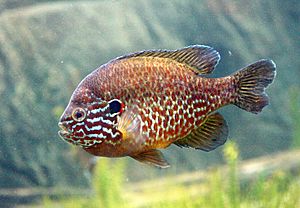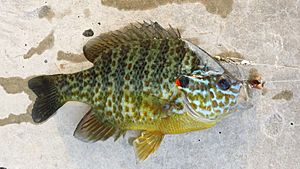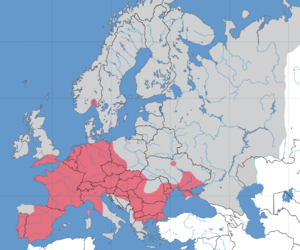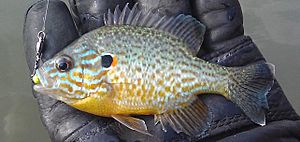Pumpkinseed facts for kids
Quick facts for kids Pumpkinseed |
|
|---|---|
 |
|
| Conservation status | |
| Scientific classification | |
| Synonyms | |
|
The pumpkinseed (Lepomis gibbosus) is a cool freshwater fish. It belongs to the sunfish family, called Centrarchidae. This fish lives in North America. People also call it the pond perch, common sunfish, or just sunny.
Contents
Where Pumpkinseed Sunfish Live
Natural Homes and New Places
The pumpkinseed fish naturally lives in North America. You can find them from New Brunswick down to South Carolina on the east coast. Their natural home also stretches inland through Iowa and Pennsylvania.
These fish have been moved to many other places too. Now, you can find them across North America. They live from Washington and Oregon on the Pacific Coast. They also live all the way to Georgia on the Atlantic Coast. Most pumpkinseeds are in the northeastern United States. They are less common in the south-central or southwestern parts.
In Europe, pumpkinseeds are seen as an invasive species. This means they were brought there by humans. They can sometimes take over the homes of native fish.
What Pumpkinseed Sunfish Look Like

Pumpkinseeds are usually about 10 centimeters (4 inches) long. But some can grow up to 28 centimeters (11 inches). They usually weigh less than 0.5 kilograms (1 pound). The biggest one ever caught weighed 0.68 kilograms (1 pound, 8 ounces). Robert Warne caught it in Honeoye Lake, New York.
These fish have bright colors like orange, green, yellow, or blue. They have speckles on their sides and back. Their belly is usually yellow-orange. Their scales can be olive-green, brown, bright orange, or blue. Their sides have faint green or blue bars. These bars are often easier to see on female pumpkinseeds.
Orange spots might cover their top, bottom, and tail fins. Their cheeks have blue lines. A special mark is the orange-red spot on the edge of their black gill cover. Their front fins can be clear or amber. The spines on their back fin are black.
How They Got Their Name
Pumpkinseeds have a small body shape. It looks a lot like a pumpkin seed. This is how they got their common name. They have a small mouth. Their upper jaw stops right under their eye.
Pumpkinseed vs. Bluegill
Pumpkinseeds look very much like bluegill fish. They often live in the same places. One way to tell them apart is their gill flap. Both fish have a black flap. But the pumpkinseed has a red spot on the back of its flap. It looks like a half-moon. Pumpkinseeds also have seven or eight duller vertical bands on their sides. Bluegills have brighter bands.
Where Pumpkinseed Sunfish Live
Pumpkinseeds like warm, calm lakes and ponds. They also live in pools of small rivers. They prefer clear water with lots of plants. These plants give them places to hide. They usually stay close to the shore. You can find many of them in shallow, safe areas.
They eat at all water levels, from the top to the bottom. They feed most often in the afternoon. Pumpkinseed sunfish often swim together in groups. These groups can also include bluegills and other sunfish.
Pumpkinseeds can handle low oxygen levels better than bluegills. But they do not like very warm water as much. Young fish swim in groups near the shore. Adult fish usually travel in small groups of two to four. They prefer slightly deeper water that still has cover. Pumpkinseeds are active during the day. At night, they rest near the bottom. They might hide in rocks or near sunken logs.
What Pumpkinseed Sunfish Eat
Pumpkinseeds eat many small things. They find food both on the water's surface and at the bottom. Some of their favorite foods are insects, mosquito larvae, and small snails. They also eat crabs, worms, tiny minnows, and even other small pumpkinseeds. They have been seen eating small crawfish. Sometimes, they eat small bits of plants, frogs, or tadpoles.
They are very good at eating mosquito larvae. They also eat detritus, which is dead plant and animal matter. The pumpkinseed sunfish has a mouth that opens at the front of its snout.
Pumpkinseed sunfish that live where there are bigger snails have bigger mouths. They also have stronger jaw muscles. This helps them crack the shells of the larger snails.
Pumpkinseed Sunfish and People
Pumpkinseed sunfish are usually very eager to bite a worm. This makes them easy to catch when fishing. Many anglers (people who fish) think pumpkinseeds are a bit of a bother. This is because they bite so easily. Fishermen might be trying to catch other fish.
Young fishermen really like pumpkinseeds. This is because they are easy to catch and there are many of them. They also live close to the shore. Many people think pumpkinseed meat tastes good. But they are not a popular sport fish because of their small size.
It is easy to catch pumpkinseeds from the shore. They stay in shallow water and eat all day. They will bite almost any bait. This includes garden worms, insects, leeches, or small pieces of fish. They also go for small fake lures. You can even catch them with a fly rod using wet or dry flies. In early winter, they will bite on grubs. But they are less active in mid to late winter.
Even though they are easy to catch, adults also like to fish for them. These fish fight hard on the line. They also taste great and are healthy to eat.
The world record for a pumpkinseed is 0.68 kilograms (1 pound, 8 ounces). It was caught near Honeoye, New York in 2016.
How Pumpkinseed Sunfish Are Protected
The pumpkinseed sunfish is very common. It is not on any endangered lists. The IUCN says it is of "Least Concern". This means it is not threatened.
Building near shorelines can disturb where pumpkinseeds lay their eggs. Erosion from heavy lake use can also cause problems. Pumpkinseeds are sensitive to dirt and pollution. This makes them a good sign of how clean and healthy the water is.
Reproduction and Life Cycle
Building Nests
In late spring or early summer, when the water gets warm (about 13-17 degrees Celsius or 55-63 degrees Fahrenheit), male pumpkinseeds start building nests. They usually build these nests in shallow water. They like sandy or gravelly lake bottoms.
Males use their tail fins to dig shallow, oval-shaped holes. These holes are about twice the length of the fish. They also use their mouths to remove dirt and big rocks from their nests.
Laying Eggs
Nests are built in groups, called colonies. Each colony has about three to 15 nests. Pumpkinseeds often build their nests near bluegill colonies. Sometimes, the two species even have babies together.
Male pumpkinseeds are strong and protective. They defend their nests by spreading their gill covers. Because they are so protective, pumpkinseeds usually have larger territories than bluegills.
Female fish come from deeper water after the nests are ready. The male releases sperm, and the female releases eggs. A female might lay eggs in more than one nest. Also, more than one female might use the same nest. Sometimes, more than one female will lay eggs with a male in one nest at the same time. Females can produce 1,500 to 1,700 eggs. The number depends on their size and age.
Caring for Young
Once laid, the eggs stick to gravel, sand, or other things in the nest. They hatch in as little as three days. Females leave the nest right after laying eggs. But males stay and guard their babies. The male guards them for about 11 days. If a baby fish swims away, the male brings it back to the nest in his mouth.
The young fish stay near the shallow breeding area. They grow to about 5 centimeters (2 inches) in their first year. They can start having their own babies when they are about two years old. Pumpkinseeds have lived up to 12 years in aquariums. But in nature, most live for six to eight years.
How Pumpkinseed Sunfish Adapt
Pumpkinseed sunfish have special ways to fit into their homes. Their skin colors help them blend in. The patterns on a pumpkinseed look like sunlight reflecting on shallow water. This helps them hide.
Spines and Sensing
The pumpkinseed sunfish has a special way to protect itself. It has 10 to 11 sharp spines along its back fin. It also has three more spines on its bottom fin. These sharp spines help the fish defend itself.
Pumpkinseeds can also sense when predators or prey are near. They use a lateral line system. This system helps them feel changes or movements in the water.
Eye Spots and Jaw Strength
The bright colored gill plates of the pumpkinseed also help them. They have a dark spot at the back of the gill plate. This is like an eye spot. It makes the fish's eye look bigger and further back on its body. This makes the fish seem up to four times larger than it really is.
When a pumpkinseed feels in danger, it flares its gills. This makes it look bigger and shows off its bright red color. Male fish also flare their gills in spring. This shows who is stronger and protects their area.
In the southern parts of where they live, pumpkinseeds have bigger mouths. They also have very strong jaw muscles. This helps them eat small crabs and snails. Their strong jaws let them crack the shells of their prey. This is why they are sometimes called 'shellcrackers'.
What the Name Means
The scientific name Lepomis comes from Greek words. Lepomis means 'scaled gill cover'. gibbosus means 'humped'. The bright red spot on their gill flap is a key feature. The pumpkinseed sunfish is widely known for its body shape, which looks like a pumpkin seed. This is where its common name comes from.
See also
 In Spanish: Perca sol para niños
In Spanish: Perca sol para niños




